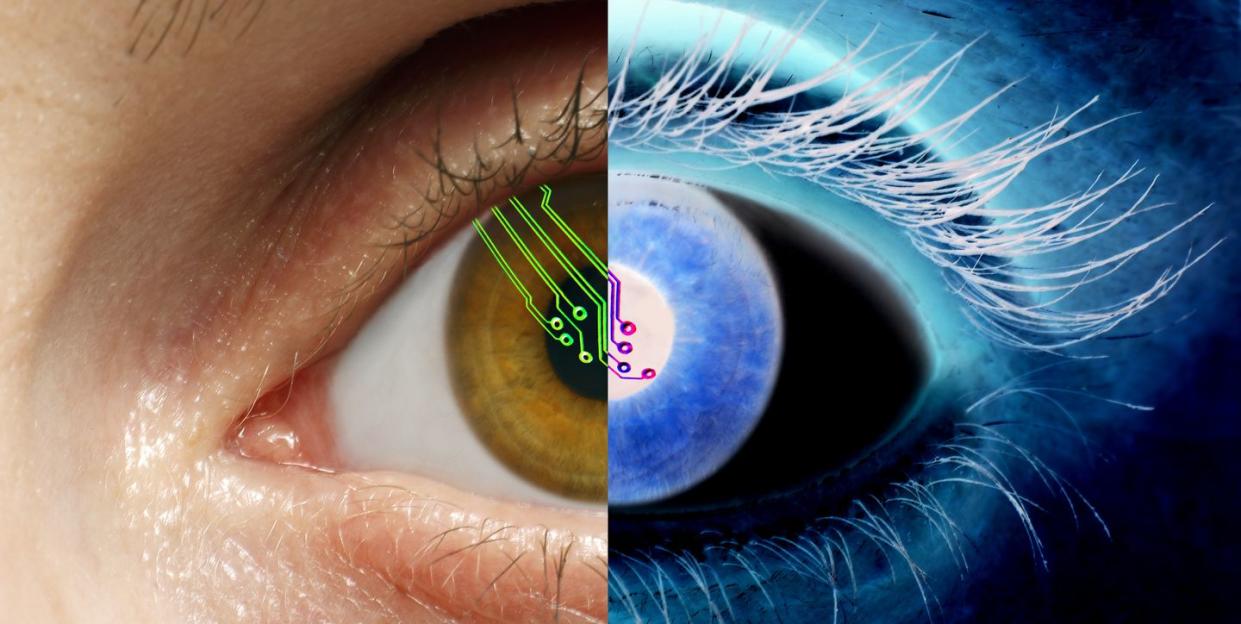The Bionic Eye That Could Allow Humans to Manipulate Reality

Science Corp. is working on a visual prothesis that the company says has shown success in rabbits.
The microLED film sits on the retina and moves with the eye for constant pixel-to-cell mapping.
Offering resolution eight times denser than an iPhone 13 Super Retina display, the device offers sophisticated vision.
It’s called Science Eye, and it could be coming to humans in the “not-too-distant future,” if Science Corp. has its way. Consider Science Eye a visual prosthesis that combines high-tech electronics with gene therapy to erase conditions like retinitis pigmentosa (which breaks down the retina and causes sight loss) and dry age-related macular degeneration (which blurs out the center of your vision).
In essence, Science Eye aims to replace blindness with high-powered pixel-producing technology.
Vision starts with photoreceptors, cells in the eye that take in light and convert it to electrical signals. The photoreceptors then pass those electrical signals along to nerve cells called retinal ganglion cells (RGCs), which pass the electrical signal to the brain to actually create the image we see.
But those photoreceptors in the retina can degenerate, losing their ability to translate light signals to electrical signals and causing blindness. The RGCs, however, are often still alive, and could still do their work if they could get the signals they need. So, Science Eye aims to turn retinal ganglion cells (RGCs) into photoreceptors, reintroducing the first step in the process of sight and keeping the ability to make that light-to-vision translation active.
One part of the visual prosthesis, a microLED device dubbed FlexLED, is based on a combination of a thin-film retinal display and the activation of RGCs. This .03mm thin, flexible, wireless uLED display with over 8,000 pixels is affixed to the back surface of the eye. The electronics package that goes along with it is mounted on top of the eye, much like existing glaucoma drainage implants.
The FlexLED gathers the light and, with the targeted activation of the RGCs, allows the brain to convert that light into sight. At least, that’s the plan. A study released in bioRxiv earlier in 2023 claims the team is making progress, and that the technology appears to work—successfully turning RGCs into photoreceptive cells and using FlexLED to light up the brain.
The testing part is tricky, though. You can’t just go manipulating human cells. So, the team has started growing a retina to test the plan in human cells, says Science co-founder Alan Mardinly, according to CNet. They’ve also enlisted the help of rabbits to help show that Science Eye works on multiple levels.
In the rabbit models, optical stimulation of the retina using the FlexLED elicits activity in the visual cortex. Science Corp. says, via the study text, this technology can scale to “hundreds of thousands of pixels, providing a route toward an implantable optogenetic visual prosthesis capable of generating vision by stimulating RGCs at near-cellular resolution.”
The FlexLED requires a specific wavelength of light, according to CNet, compelling Science Eye to come with camera-affixed glasses that wirelessly send information to the FlexLED to help bring that pixel power to play.
As Science Corp. remains optimistic about the potential of Science Eye, the next step involves gaining approval to do an in-human clinical study. If that proves successful, the team hopes to move toward commercialization. That’ll be a sight.
You Might Also Like
